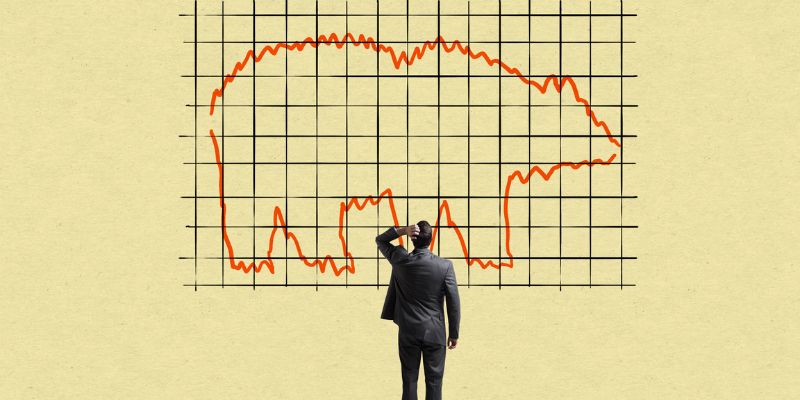Growth Stocks Uncertainty: Navigating the High-Risk High-Reward Path?
Let’s get real about what are the risks of investing in growth stocks? You might have heard that they can lead to big wins. But wait—there’s more to the story. Growth stocks are like wild horses – they can sprint to success or suddenly buck. I’ll guide you through this rocky ride, starting with why these stocks swing in price and what big PE numbers really say about value. We’ll then dig into how well they turn sales into profits over time. Buckle up, my friends, because together, we’re riding through the stormy world of high-stakes growth stocks!
Understanding Growth Stock Volatility and Price Valuation
Addressing High PE Ratio Concerns and Overvaluation
When we talk about investing in hot growth stocks, think of a roller coaster. Yes, that’s right – twists, turns, and big drops! That’s growth stock volatility for you. It means the price of your stock can swing high or low, real quick. If you buy these stocks, you’re in for a ride. But why so bumpy? It’s often the high PE ratio that gets folks uneasy.
What’s a PE ratio? It tells you if a stock’s price is high or low compared to its earnings. For growth stocks, these numbers are usually high. That’s because many bet the company will make more money later. But high PE also screams “overvaluation” to some. Overvaluation means people may be paying too much for the stock. That can be risky if the company’s future doesn’t shine as bright as they hope.
Now let’s tackle what overvaluation of growth companies means. You’ve got this business, right? Everyone loves it, and the price rockets. But the question is – does the company really deserve that star status? Sometimes it’s yes, sometimes it’s a no. If it’s a no, that’s when you might lose money if the stock price falls.
Evaluating Long-Term Profitability Versus Revenue-Based Optimism
Looking ahead, long-term profitability is the big prize. Can this flashy growth company keep making dough down the road? That’s what you want to know. But here’s the catch. There’s something called “revenue-based optimism” – it’s when folks get all excited just because a company is selling more, even if it’s not making profits yet. They’re betting on the future. Pump the brakes here. More sales don’t always mean a win in the long run.
So, what is long-term profitability uncertainty? Simply put, it’s not knowing if the company can keep up the good work. Will it grow and cash in over the years? Will it be able to fight off rivals and stay cool? That’s the gamble with growth stocks.
Think of your own lemonade stand. Selling lots means people like your lemonade now. But will they keep coming back? Will you be able to sell at a good price if sugar costs soar? Do you have plans if the weather turns sour or if a new soda shop opens next door? That’s the kind of stuff growth companies face. And that’s what you, as an investor, must chew on when putting your money into growth stocks. It’s a mix of thrill and careful thinking, every step of the way.

Economic Indicators and Their Effects on Growth Stocks
Interest Rate Impact and the Challenges in Growth Versus Value Investing
When interest rates go up, growth stocks often fall. That’s because their future profits get less attractive. Value stocks do better. They seem safer as they often pay dividends.
Why do higher rates hit growth stocks harder? Growth stocks count on future profits. High rates make these profits less valuable today.
So, the price of growth stocks falls.
Recognizing Economic Downturns and Competitive Industry Risks
During economic slumps, even strong growth firms may struggle. Industry battles also hit them hard.
What happens to growth stocks in a downturn? Their sales often drop. This can happen fast.
New tech changes things quickly too. It can hurt older companies. New rules can also change how firms work.
Keep a close watch on these risks. It’s key.
Predicting Market Movements and Their Implications for Growth Investors
Analyzing Market Sentiment and Financial Bubbles
Smart investors keep an eye on market sentiment. This reveals how people feel about stocks. When many get too hopeful, stocks may soar more than they should. This can form a bubble. Financial bubbles pop often. When they do, watch out! Stocks can drop hard and fast. This hurts if you only have growth stocks. They’re the ones that get the most hurt in a bubble burst.
Yet, market warmth can be tricky. People get eager when news sounds good. This pushes up stock prices. But growth stocks can shoot up too high. Why does this happen? Investors often follow others, showing an investor herd mentality. They buy because others buy, not due to solid facts. This makes growth stock prices swing a lot or growth stock volatility.
So, do growth stocks always mean high risk? Not always, but growth stocks often have high PE ratios, which means you pay a lot for each dollar they earn. High PE worries tell us stocks face a drop if things go south.
Assessing the Viability of Growth Stocks Amidst Technological and Regulatory Changes
Now, let’s dig into growth stocks in a changing world. New tech can make a company zoom to the top. Or it can sink it fast. This is the impact of technological disruption. Many growth stocks are in tech, where change never stops. So, they can either win big or lose hard.
Rules and laws also shift a lot. These are regulatory changes. They affect how companies do their work. If rules get tough, some stocks can fall. But some adapt and rise even higher. Smart growth investors always watch for new tech or rule shifts.
Remember to keep these ideas in mind when picking stocks. You want to make money, sure. But don’t forget, the path of growth stocks can twist and turn. It’s a high-reward game, but only if you play it right and stay aware.

Strategic Investment Decisions in High-Growth Scenarios
The Importance of Diversification and Asset Allocation in Growth Investing
When you put money into growth stocks, think of a pie. Each slice should be a different kind, like tech, health, or retail. This way, if one part sinks, your whole pie doesn’t flop. Experts say don’t put all your eggs in one basket. I say, don’t bet your whole pie on one flavor.
A big storm, like a market drop, can hit hard. If your pie has many flavors, it might just get a little soggy, not ruined. This is what we call diversification. It protects your investment pie. Too many sweet slices, or risky stocks, can lead to a bellyache.
Now, how big should each slice be? That’s asset allocation. It’s about balance. Young people might have bigger, riskier slices. Older folks might go for more steady, small slices like bonds or funds. It’s all about when you’ll need that money and how much risk you’re okay with.
Growth stocks can jump high but also fall fast. They’re like balloons in a windstorm. To keep your balloon from flying away, you must tie it down. That means, mix it up with other investments to hold it steady.
Formulating Exit Strategies and Managing the Risks of Buy-and-Hold Strategies
Having an exit plan is key. Ask yourself, “When do I sell?” Maybe it’s a certain price, or a date, or if the company changes. It’s like having a map on a hike. You need to know when it’s time to head back so you don’t get lost in the woods.
Long-term is often smart, but it’s not just “set and forget.” Like owning a car, you can’t just drive it. You gotta check the oil, the tires, and keep it running well. Check on your stocks, too. Make changes if needed. The market is like the weather – always changing. Be ready to put on a raincoat or sunscreen.
Some folks like to wait it out, no matter what. That’s buy-and-hold. It can pay off big time, but it’s like riding a roller coaster. You must buckle in and be ready for the dips and flips. Sometimes, it might be smarter to hop off before the big drop.
The trick is to know the ride. Research, watch the news, and understand your stocks. Be like a detective. Look for clues that tell you when trouble is coming or when it’s all clear.
So, here’s the takeaway: mix it up, have a plan, and stay sharp. Diversification is your safety net. Asset allocation is your balance beam. And always have your map — your exit strategy — in your back pocket. Remember, investing isn’t just about making money. It’s about keeping it, too.
In this post, we’ve tackled the bumpy ride that comes with growth stocks. We looked at why high PE ratios make some folks uneasy and talked about betting on the future with stocks that may not make cash today. We dived deep into how twists in the economy, like rate hikes, can shake up growth stocks more than others. And, we didn’t shy away from the hard truth that downturns and tough competition are part of the deal.
We also peeled back the layers on making smart moves before markets do a flip. Reading into market moods and staying sharp on tech and rules that change the game is key. And lastly, we chatted about not putting all eggs in one basket and knowing when to say goodbye to an investment.
Remember, growth investing is like surfing: catch the right wave, and you’re set for an exhilarating ride. Miss it, and you could wipe out. So stay wise, stay nimble, and keep learning—your financial future deserves that much. Keep the lessons from this post in your investing toolkit, and you’ll be ready for the ups and downs that come with chasing growth.

Q&A :
What are the potential downsides to investing in growth stocks?
Growth stocks, typically characterized by their high potential for expansion and earnings, can present several risks for investors. The primary concerns usually include their susceptibility to market volatility, overvaluation due to high expectations, inflated prices unrelated to fundamentals, and a general lack of dividends, which can deter income-seeking shareholders. Additionally, these stocks can plummet significantly during market downturns or if the company fails to meet the bullish forecasts.
How does market volatility affect growth stock investments?
Market volatility can have a pronounced impact on growth stocks more so than on value or dividend stocks. Since growth stocks are often valued for their future potential rather than current earnings, they can be more sensitive to changes in investor sentiment and market conditions. High volatility can lead to sharp price swings, posing a considerable risk for investors who may need to sell during a downturn.
Are growth stocks overvalued more often than other types of stocks?
Growth stocks tend to trade at higher price-to-earnings (P/E) ratios than other types of stocks due to expectations of high growth rates in earnings. These elevated valuations raise concerns about overvaluation, especially in exuberant market climates where investor optimism may push prices beyond sustainable levels based on fundamental analysis. This phenomenon can lead to corrections or pronounced losses if the growth fails to materialize or if there is a market-wide re-evaluation of stock values.
Can you lose money by investing in growth stocks?
Yes, investing in growth stocks carries the risk of losing money, just like any other form of investment. If a growth company’s business model fails, if it falls short of its growth predictions, or if the overall market enters a bear phase, its stock price may decline, sometimes substantially. Investors need to be aware that the higher potential reward associated with growth stocks comes with the risk of higher losses.
Why are growth stocks often not preferred for income investing?
Income investing is a strategy focused on generating regular income from investments, often through dividends. Growth stocks, however, typically reinvest their earnings back into the company to fuel further growth and expansion rather than paying out dividends. This lack of dividend payouts makes growth stocks less attractive to income-oriented investors who rely on regular income streams from their investments.

